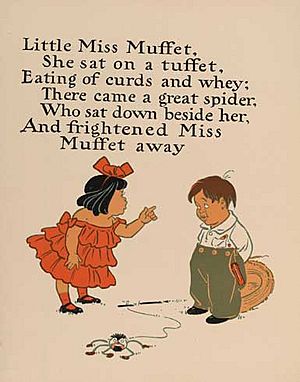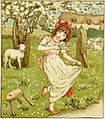Little Miss Muffet facts for kids

William Wallace Denslow's illustrations for one version of the rhyme, from a 1901 edition of Mother Goose
|
|
| Publication date | 1805 |
|---|---|
"Little Miss Muffet" is a well-known English nursery rhyme. It tells the story of a girl who gets scared by a spider! This rhyme was first written down in 1805, but it might be much older. It is listed in the Roud Folk Song Index as number 20605, which helps researchers keep track of folk songs and rhymes.
What the Rhyme Says
The rhyme "Little Miss Muffet" first appeared in a book called Songs for the Nursery in 1805. Over the years, there have been many slightly different versions of the rhyme.
The most common version of the rhyme goes like this:
- Little Miss Muffet
- Sat on a tuffet,
- Eating her curds and whey;
- There came a big spider,
- Who sat down beside her
- And frightened Miss Muffet away.
Sometimes, older versions of the rhyme used "of" instead of "her" in the third line. Also, the spider was sometimes called a "little spider" instead of a "big spider." This shows how rhymes can change a little bit over time as they are passed down.
There were also some very different versions of the rhyme. For example, one version from 1812 started with "Little Mary Ester sat upon a tester." Another version from 1842 began, "Little Miss Mopsey, Sat in the shopsey." In some places, like the United States, "whey" was even replaced with "pie"!
What is a Tuffet?
The word "tuffet" in the rhyme might make you think of a low seat or a footstool. However, when this rhyme was first written, "tuffet" probably meant a small, grassy hill or a little mound of earth.
The Oxford English Dictionary even says that the idea of a "hassock or footstool" meaning for "tuffet" is "doubtful." It suggests that people might have started thinking of it as a seat because of this very nursery rhyme!
Where Did the Rhyme Come From?
The exact beginnings of "Little Miss Muffet" are not completely clear. Even though it was first written down in 1805, it is likely much older than that.
This rhyme is similar to other old nursery rhymes like "Little Polly Flinders" and "Little Jack Horner." "Little Jack Horner," for example, was known to be around as early as 1720. This suggests that "Little Miss Muffet" could also have been sung and shared for many years before it was finally printed in a book.
Images for kids





